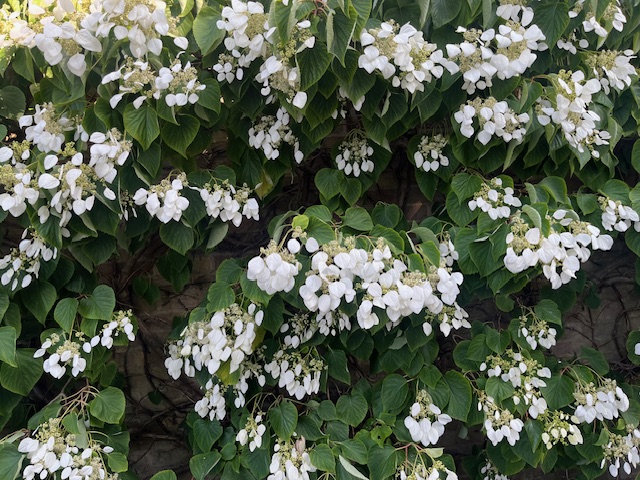Description
Garden Advice Notes
Hydrangea anomala subsp. petiolaris is a vigorous deciduous climber with elegant, self-clinging stems and masses of creamy-white lacecap flowers in early summer. Native to the woodlands of the Himalayas and eastern Asia, this subspecies of Hydrangea anomala has become widely cultivated for its adaptability and striking ornamental value.
The foliage is lush and dark green, with oval, serrated leaves that create a dense, layered look as the plant matures. From late spring to early summer, the plant bursts into bloom with flattened clusters of white flowers, each up to 20cm (8 inches) across, composed of central fertile florets surrounded by a ring of showier sterile florets.
Hydrangea anomala subsp. petiolaris climbs using aerial roots that attach easily to brick, stone, or tree bark. Once established, it can reach up to 12m (40 feet) in height and spread to around 4m (13 feet), making it ideal for covering large walls or tree trunks in shaded areas.
Soil Type
Hydrangea anomala subsp. petiolaris prefers moist, fertile, well-drained soil that is rich in organic matter. It performs best in slightly acidic to neutral soils (pH 5.5–7.0).
-
Improve poor soils with compost, leaf mould, or other organic materials to enhance moisture retention.
-
Avoid waterlogged conditions, especially in winter.
-
Mulch annually with compost or bark chips to maintain soil moisture and feed the roots.
Location
This climber thrives in partial to full shade, making it perfect for north- or east-facing walls, where other plants may struggle. It tolerates more sun in cooler, moist climates but prefers protection from hot, direct afternoon sun.
Ideal uses include:
-
Shaded walls and fences
-
Growing up mature trees
-
Woodland or courtyard gardens
It is self-supporting and does not need training, but initial guidance is helpful in early years.
Pest and Disease Problems
Hydrangea anomala subsp. petiolaris is generally hardy and problem-free but may occasionally be affected by:
-
Aphids – May cluster on young shoots; typically controlled by beneficial insects or insecticidal soap.
-
Scale insects – Appear as small brown discs on stems; treat with horticultural oil if needed.
-
Powdery mildew – More likely in dry, enclosed sites; improve air flow and avoid overhead watering.
-
Leaf spot – Wet conditions may lead to fungal spotting; remove and dispose of affected leaves.
Proper site selection and good garden hygiene will prevent most issues.
Propagation
Propagation is best carried out by layering or taking softwood cuttings.
-
Layering: In spring or autumn, select a low-growing shoot and pin it into the soil. Once roots have developed (usually after a season), the new plant can be separated and replanted.
-
Softwood cuttings: Taken in early summer from healthy, non-flowering shoots. Use a gritty, well-drained compost and keep humid under cover.
Plants grown from cuttings may take a few seasons to flower, but this method ensures identical characteristics to the parent plant.
Pruning, Cutting Back and Dividing
Hydrangea anomala subsp. petiolaris requires little pruning once established but can benefit from occasional shaping or rejuvenation.
-
Pruning: After flowering, remove spent blooms and prune lightly to maintain shape or limit growth.
-
Cutting back: In late winter or early spring, damaged or congested stems can be cut back to healthy buds.
-
Dividing: As with other woody climbers, division is not recommended. Propagation should be done via cuttings or layering.
It is a slow grower in its first few years, but once established, it becomes vigorous and long-lived.
How It Differs from Hydrangea petiolaris
Although the names are often used interchangeably, Hydrangea anomala subsp. petiolaris is technically the correct botanical name for what is commonly called Hydrangea petiolaris. The two refer to the same plant, but the term Hydrangea petiolaris is sometimes used informally or commercially.
However, some sources and nurseries distinguish between the two:
| Feature | Hydrangea anomala subsp. petiolaris | Hydrangea petiolaris (informal distinction) |
|---|---|---|
| Botanical accuracy | Correct botanical name | Common or outdated usage |
| Growth habit | Vigorous, more widely available | Often treated as a synonym |
| Availability | Found in botanical collections & retail | Same plant under different label |
| Taxonomic status | Subspecies of Hydrangea anomala | Sometimes treated as separate species |
In practice, they are the same plant, with Hydrangea anomala subsp. petiolaris being the current accepted scientific name.
Please note our plants in most instances are delivered by our own GardenAdvice expert gardeners. Please note we only supply plants to GardenAdvice members and clients
Our plants are guaranteed for 24 months for more details Click Here























